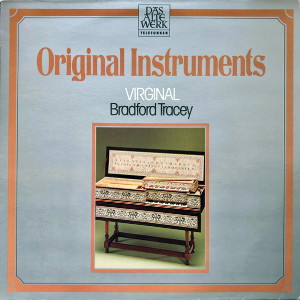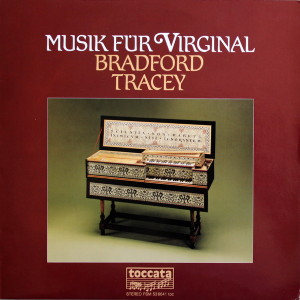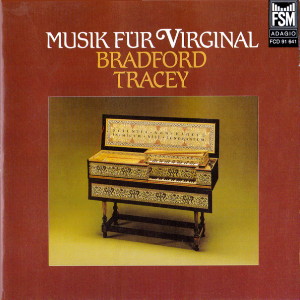 |
1 LP -
Telefunken 6.42074 AP (p) 1979
|
 |
| 1 LP -
Toccata FSM 53 641 (p) 1979 |
 |
| 1 CD -
FSM Adagio FCD 91 641 (c) 1990 |
|
| ORIGINALINSTRUMENTE - Virginal |
|
|
|
|
|
|
|
| Jan Pieterszoon
Sweelinck (1562-1621) |
Praeludium
Toccata (aus: Fitzwilliam
Virginal Book, ca. 1625)
|
|
5' 52" |
A1 |
Thomas Morley
(1557-1602)
|
Pavane
and Galliard "Lachrymae" (aus:
Fitzwilliam Virginal Book, ca. 1625) |
|
7' 36" |
A2 |
Orlando di Lasso
(um 1532-1594)
|
"Susanne
un jour" (aus: Tisdale's
Virginal Book, anfang 17. Jh.) |
|
4' 55" |
A3 |
William Tisdale
(17. Jh.)
|
Coranto
(aus: Tisdale's Virginal Book,
anfang 17. Jh.) |
|
1' 05" |
A4 |
| Anonym |
Almain
(aus: Parthenia In-Violata, or
Mayden-Musicke for the Virginalls
and Bass-Viol, um 1624/25) *
|
|
1' 38" |
A5 |
| Anonym |
The
Irish Dance (aus: Parthenia
In-Violata, or Mayden-Musicke for
the Virginalls and Bass-Viol, um
1624/25) *
|
|
0' 58" |
A6 |
| Anonym
|
The
Lord's Masque (aus: Parthenia
In-Violata, or Mayden-Musicke for
the Virginalls and Bass-Viol, um
1624/25) *
|
|
1' 27" |
A7 |
| Anonym
|
Almain
(aus: Parthenia In-Violata, or
Mayden-Musicke for the Virginalls
and Bass-Viol, um 1624/25) *
|
|
1' 08" |
A8 |
| Anonym
|
Coranto
(aus: Parthenia In-Violata, or
Mayden-Musicke for the Virginalls
and Bass-Viol, um 1624/25) *
|
|
1' 00" |
A9 |
| Anonym |
Miserere
(aus: Parthenia In-Violata, or
Mayden-Musicke for the Virginalls
and Bass-Viol, um 1624/25) *
|
|
1' 43" |
A10 |
| Anonym |
The
King's Morisck (aus: Parthenia
In-Violata, or Mayden-Musicke for
the Virginalls and Bass-Viol, um
1624/25) *
|
|
2' 22" |
A11 |
John Bull (um
1562-1628)
|
Lord
Lumley's Paven und Galliard
(aus: Fitzwilliam Virginal Book, ca.
1625) |
|
7' 25" |
B1 |
Orlando
Gibbons (1583-1625)
|
Fantasia
in a
|
|
3' 13" |
B2 |
Orlando
Gibbons
|
Ground
in a |
|
3' 03" |
B3 |
| Samuel
Scheidt (1587-1654) |
Bergamasca |
|
3' 50" |
B4 |
John Bull
|
The
Prince's Galliard
|
|
2' 38" |
B5 |
John Bull
|
Praeludium
and Fantasia
|
|
3' 59" |
B6 |
|
|
|
|
|
| Bradford TRACEY,
Virginal (Doppelvirginal nach
Hans Ruckers, Antwerpen 1591, von
John Koster, Boston 1974) |
|
Brian FRANKLIN,
Viola da gamba *
|
|
|
|
|
|
Luogo
e data di registrazione |
|
Schloß
Bad Krozingen, Baden-Württemberg
(Germania) - 1979
|
|
|
Registrazione:
live / studio |
|
studio |
|
|
Recording
Supervision
|
|
Paul
Dery
|
|
|
Edizione LP |
|
TELEFUNKEN
- 6.42074 AP - (1 LP - durata 53'
33") - (p) 1979 - Analogico |
|
|
Originale LP
|
|
TOCCATA
- FSM 53 641 - (1 LP - durata 50'
33") - (p) 1979 - Analogico |
|
|
Prima Edizione CD |
|
FSM
Adagio - FCD 91 641 - (1 CD -
durata 50' 33") - (c) 1990 - ADD
|
|
|
Note |
|
Produced
by Toccata
|
|
|
|
|
The
virginal is a
rectangular, or
sometimes
polygonal, form of
the harpsichord in
which there is a
single set of
strings running
nearly parallel to
the front of the
case. The earliest
description of the
harpsichord by
Henricus Arnaut de
Zwolle (circa
1440) mentions the
possibility of the
rectangular form
and the term
"virginale" is
used a few years
later by Paulus
Paulirinus de
Praga (circa
1460), who likens
its tone to the
sweet voice of a
virgin. The word,
however, may
actually stem from
the latin "virga"
(stick), referring
to the
jack-action. The
Italian word fo
the instrument
"spinetta", may
similary have been
derived from the
Latin "spina"
(thorn), referring
to the pointed
piece of quill
which plucks the
strings.
Virginals were
made in large
numbers throughout
Europe until about
1675 and there
survive excellent
examples from
Italy, England,
Germany, and the
Low Countries. A
high point was
reached in the
instruments made
in Antwerp from
about 1550 to
1650, most notably
those made by the
several menbers of
the Ruckers
family. The
sophisticated
design,
craftmanship, and
decoration of
their virginals
demonstrates that
these were not
regarded merely as
less expensive
substitutes for
the wing-shaped
harpsichord. After
about 1580 Flemish
virginals were
made in two basic
configurations:
the spinet with
its sharp, bright
tone, in which the
keyboard was
placed to the left
and the muselar in
which the keyboard
was placed to the
right so that the
strings were
plucked near their
centers, resulting
in a rich, hollow
tone quite unlike
any that could be
produced by the
harpsichord. The
spinet-type was
similar to the
virginals of other
countries, but the
muselar was
uniquely Flemish.
Muselars generally
had a stop which,
when engaged,
would cause the
bass strings to
buzz and rattle.
The Renaissance
love of varied
tone-color was
further indulged
in the double
virginal, also
called the "mother
and child", in
which a small
virginal at octave
pitch, the child,
was stored like a
drawer in a large
virginal, the
mother, which
could be either
spinet or muselar.
The two
instruments could
be played
separately or the
child could be
placed upon the
mother in such a
way that the two
instruments were
coupled. The
result was a
two-manual
instrument with 8'
plus 4' on the
lower manual and
4' on the upper,
so that the two
keyboards could be
used for the rapid
alternation or
simultaneous use
of contrasting
tone-colors. This
was not possible
on the
contemporary
two-manual
harpsichords,
whose keyboards
were a fourth
apart in pitch and
which were
constructed so
that the stops of
one keyboard had
to be disengaged
before those of
the other keyboard
could be used.
Although double
virginals were
particularly
common in the Low
Countries, from
which come all
fourteen surviving
historical
examples, the
instrument was
known throughout
Europe and one by
Hans Ruckers was
even sent to Peru.
Thus the
instrument here
recorded, a close
copy of a double
virginal with a
muselar-type
mother after Hans
Ruckers, Antwerp,
1591, is
appropriate not
only to the works
of the Dutchman
Sweelinck and John
Bull, who spent
his last years in
Antwerp, but also
to those of the
former's German
pupil Samuel
Scheidt and the Englishmen
Thomas Morley
and Orlando
Gibbons.
John
Koster
|
|
|

